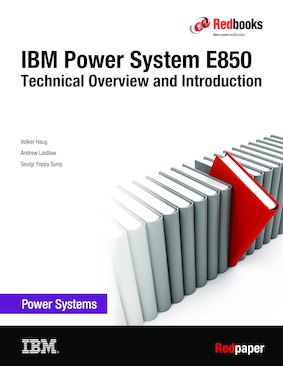
Published on 17 June 2015, updated 25 April 2017
Read in Google Books
Share this page:
ISBN-10: 0738454222
ISBN-13: 9780738454221
IBM Form #: REDP-5222-00
Authors: Scott Vetter, Volker Haug, Andrew Laidlaw and Seulgi Yoppy Sung
Abstract
This IBM® Redpaper™ publication is a comprehensive guide covering the IBM Power System E850 (8408-E8E) server that supports IBM AIX®, and Linux operating systems. The objective of this paper is to introduce the major innovative Power E850 offerings and their relevant functions:
- The new IBM POWER8™ processor, available at frequencies of 3.02 GHz, 3.35 GHz, and 3.72 GHz
- Significantly strengthened cores and larger caches
- Two integrated memory controllers with improved latency and bandwidth
- Integrated I/O subsystem and hot-pluggable PCIe Gen3 I/O slots
- I/O drawer expansion options offer greater flexibility
- Improved reliability, serviceability, and availability (RAS) functions
- IBM EnergyScale™ technology that provides features such as power trending, power-saving, capping of power, and thermal measurement
This publication is for professionals who want to acquire a better understanding of IBM Power Systems™ products. The intended audience includes the following roles:
- Clients
- Sales and marketing professionals
- Technical support professionals
- IBM Business Partners
- Independent software vendors
This paper expands the current set of IBM Power Systems documentation by providing a desktop reference that offers a detailed technical description of the Power E850 system.
This paper does not replace the latest marketing materials and configuration tools. It is intended as an additional source of information that, together with existing sources, can be used to enhance your knowledge of IBM server solutions.
Table of Contents
Chapter 1. General description
Chapter 2. Architecture and technical overview
Chapter 3. Virtualization
Chapter 4. Reliability, availability, and serviceability